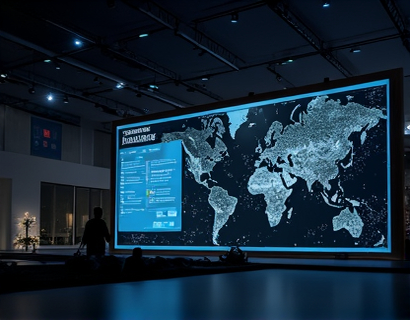Next-Gen QR Code Innovations: Elevating Business and Social Media Engagement for Modern Enterprises
In the rapidly evolving digital landscape, businesses and social media managers are constantly seeking innovative solutions to enhance engagement and streamline interactions with their audience. One such technology that has emerged as a game-changer is the next-generation QR Code, often referred to as enhanced or intelligent QR Codes. These advanced QR Codes go beyond the traditional static barcode, offering customizable and intuitive tools that significantly improve information sharing and customer interaction. This article delves into the transformative impact of these next-gen QR Codes on business and social media engagement, highlighting their features, benefits, and practical applications for modern enterprises.
Understanding Next-Gen QR Codes
Next-gen QR Codes are an evolution of the traditional QR Code, designed to meet the demands of modern digital marketing and customer engagement. Unlike standard QR Codes that primarily store URLs or static text, next-gen QR Codes can hold a variety of data types, including URLs, text, images, videos, and even complex data sets. This versatility allows businesses to create more interactive and informative experiences for their audience.
The structure of next-gen QR Codes is more sophisticated, incorporating error correction levels that ensure data integrity even when the code is partially damaged. This robustness makes them ideal for use in various environments and conditions. Additionally, these QR Codes can be dynamically updated, allowing businesses to change the linked content without needing to print new codes. This flexibility is a significant advantage in a fast-paced market where information needs to be current and relevant.
Customization and Personalization
One of the most compelling features of next-gen QR Codes is their customization potential. Businesses can tailor these codes to match their brand identity, incorporating logos, colors, and designs that align with their overall branding strategy. This level of personalization not only enhances the visual appeal of the QR Code but also reinforces brand recognition and trust among consumers.
Customization extends beyond aesthetics. Next-gen QR Codes can be programmed to direct users to specific landing pages or to trigger particular actions, such as filling out a form or making a purchase. This targeted approach ensures that the user experience is seamless and aligned with the business's objectives, reducing friction and increasing conversion rates.
Enhanced User Experience
The user experience is a critical factor in the success of any digital engagement strategy. Next-gen QR Codes are designed to provide a smooth and intuitive interaction for users. When scanned, these codes can instantly redirect users to relevant content, eliminating the need for manual input and reducing the likelihood of errors. This instant access to information enhances user satisfaction and encourages further engagement.
Moreover, next-gen QR Codes can be integrated with various digital platforms and tools, such as CRM systems, social media accounts, and e-commerce platforms. This integration allows for a more cohesive and personalized user journey, as businesses can track user interactions and tailor their responses accordingly. For instance, a QR Code placed in a physical store can link to a customer's previous purchases or preferences, enabling personalized recommendations and offers.
Boosting Social Media Engagement
Social media platforms are a crucial channel for businesses to connect with their audience and promote their brand. Next-gen QR Codes can significantly enhance social media engagement by providing a direct and interactive link to a brand's online presence. For example, a QR Code shared on Instagram or Facebook can lead users to a brand's website, a special promotion, or an interactive content piece.
These QR Codes can also be used to create engaging campaigns and contests. A business can place a QR Code in a physical location or include it in a print advertisement, directing users to a landing page where they can participate in a giveaway or survey. This not only increases interaction but also provides valuable insights into customer preferences and behaviors.
Improving Customer Interaction
Customer interaction is a key component of building lasting relationships and fostering brand loyalty. Next-gen QR Codes facilitate more meaningful and interactive customer touchpoints. For instance, in retail, a QR Code on a product package can provide detailed product information, user reviews, and video demonstrations, helping customers make informed purchasing decisions.
In the hospitality industry, QR Codes can be used to enhance the guest experience. A QR Code on a hotel room key card can direct guests to the hotel's app, where they can access room services, local attractions, and personalized recommendations. This level of convenience and personalization can significantly improve customer satisfaction and loyalty.
Data Collection and Analysis
Beyond enhancing user experience and engagement, next-gen QR Codes offer valuable data collection and analysis capabilities. By integrating QR Codes with analytics tools, businesses can track the performance of their QR Code campaigns in real-time. This data includes the number of scans, user demographics, and user behavior on the linked content.
These insights are invaluable for refining marketing strategies and optimizing customer interactions. For example, if a particular QR Code campaign on a billboard is underperforming, businesses can quickly analyze the data and adjust their approach, such as changing the linked content or relocating the QR Code. This agility allows for more effective resource allocation and higher ROI on digital marketing efforts.
Security and Trust
In an era where data privacy and security are paramount, next-gen QR Codes incorporate advanced security features to protect user information and maintain trust. These codes can be secured with authentication mechanisms, ensuring that only authorized users can access the linked content. This is particularly important for businesses handling sensitive information, such as financial services or healthcare providers.
Additionally, the use of secure and dynamic QR Codes reduces the risk of tampering and fraud. Since the content can be updated remotely, businesses can quickly address any security concerns and ensure that users are directed to legitimate and trustworthy sources.
Environmental Sustainability
Next-gen QR Codes also contribute to environmental sustainability efforts. By reducing the need for printed materials, such as flyers and brochures, businesses can minimize paper waste and lower their carbon footprint. Digital content accessed via QR Codes can be easily updated and distributed without the environmental impact associated with physical printing and distribution.
Moreover, the compact size of QR Codes means they can be placed in smaller spaces, reducing the overall material usage. This makes them an eco-friendly alternative to traditional marketing materials, aligning with the growing consumer demand for sustainable practices.
Case Studies and Real-World Applications
To better understand the practical benefits of next-gen QR Codes, let's explore a few real-world applications across different industries.
In the retail sector, a fashion brand used QR Codes on product tags to provide customers with access to detailed product information, styling tips, and user-generated content. This not only enhanced the shopping experience but also increased customer engagement and sales. The brand reported a significant rise in customer interactions and a higher conversion rate compared to traditional tag methods.
In the hospitality industry, a luxury hotel chain implemented QR Codes on room keys to offer guests a seamless and personalized experience. Upon scanning the QR Code, guests were directed to the hotel's mobile app, where they could order room service, access local attractions, and receive personalized recommendations based on their preferences. This level of convenience and personalization led to higher guest satisfaction scores and repeat bookings.
In the non-profit sector, a charity organization used QR Codes in their fundraising events to direct donors to a secure donation page. The QR Codes were also linked to impact stories and videos, providing donors with a clear understanding of how their contributions make a difference. This approach not only increased donation rates but also built a stronger emotional connection with supporters.
Implementation and Best Practices
For businesses looking to integrate next-gen QR Codes into their engagement strategies, here are some best practices to consider:
- Define Clear Objectives: Determine what you aim to achieve with QR Codes, whether it's increasing website traffic, boosting sales, or enhancing customer interaction.
- Choose the Right Tool: Select a reliable and user-friendly platform for creating and managing QR Codes. Consider features such as customization options, dynamic updates, and analytics integration.
- Optimize for Mobile: Ensure that the linked content is mobile-friendly, as the majority of QR Code scans occur on smartphones.
- Test and Refine: Conduct tests to ensure that QR Codes function correctly and provide a smooth user experience. Gather feedback and make necessary adjustments.
- Monitor and Analyze: Use analytics tools to track the performance of your QR Code campaigns and make data-driven decisions to optimize your strategy.
By following these best practices and leveraging the capabilities of next-gen QR Codes, businesses can significantly enhance their digital presence and foster deeper connections with their audience.
Conclusion
The next-generation QR Code represents a significant leap forward in digital engagement tools for modern enterprises. With their customizable design, enhanced user experience, and robust data collection capabilities, these codes offer a powerful way to connect with customers and stakeholders. Whether used in retail, hospitality, marketing, or non-profit sectors, next-gen QR Codes provide a versatile and effective solution for businesses looking to elevate their engagement and stay ahead in the digital landscape.










































